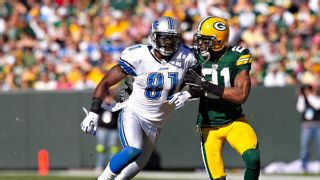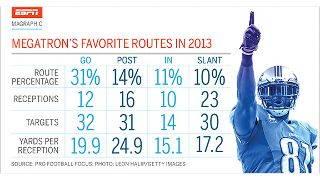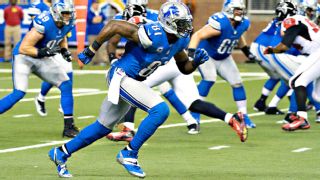ALLEN PARK, Mich. -- Imagine this. You were the best athlete in your high school. Then you were a star player in college. Now you're mentioned as one of the best defensive backs in the NFL.
You've covered tall receivers, and you've covered fast receivers. You've covered big receivers, and you've covered skilled receivers.
But this week, the Detroit Lions are on the schedule, and you're about to deal with all those traits in one imposing package. You're tasked with defending Calvin Johnson, the 6-foot-5, 236-pound superstar who ran a 4.35-second 40-yard dash in borrowed shoes at the 2007 scouting combine.
"It should be illegal for a guy to be that tall and that big and that fast. They should have banned him from the NFL," Oakland cornerback Charles Woodson said, laughing. "But he's one of those guys, man -- he's a freak of nature."
You've seen the film. You've watched him embarrass defenses and catch touchdown passes in triple coverage. You saw him rack up 329 yards on 14 catches -- the most receiving yards in a regulation game in league history -- when the Dallas Cowboys challenged him with single coverage last season.
Eventually, you will find yourself in a situation where your help disappears, and it's just you against him. At that point, you realize that facing Johnson is like nothing else in football.
"If the safety is not over the top of you and that 6-foot-5 giraffe who is running a 4.3 40 on a [go] route ..." said Cortland Finnegan, who's faced Johnson in college and the NFL. "That's when you go, 'We've got issues. We've got problems.'"
This is your assignment. Here, through the eyes of those who have done it before, is what the experience is like and how to handle it.
Heading into training camp, Johnson said he thinks the Lions are capable of winning the Super Bowl. If that is to happen, Johnson will have to be at his best even as opponents devise new plans and tap new personnel to impede him. Detroit's NFC North foes combined to draft seven defensive backs this year -- including two first-rounders.
They will soon learn that preparing to face Johnson is unique. A number of NFL players are difficult to emulate with a scout team -- Minnesota Vikings running back Adrian Peterson and Cincinnati Bengals receiver A.J. Green are two prime examples -- but even among elite players, Johnson poses particular problems.
Johnson has been targeted an average of 9.5 times a game during his career -- more than all but a handful of receivers. His physical attributes, combined with that work rate, demand a different kind of preparation.
"When you go against him, you count on the scout team wideout that mimics him and acts like Calvin Johnson," New York Giants cornerback Dominique Rodgers-Cromartie said. "But you'll never get the real picture."
Johnson's height, speed and bulk make it virtually impossible for defenders to get an accurate read on what they will face come game day. It's not just physical gifts that give Johnson an advantage. He spends a day every week dissecting his routes and locations. He critiques every element of his performance in the previous game and prior matchups.
He watches his stride to make sure it's short at the beginning of routes to avoid giving away his intentions. He watches his hands at the line of scrimmage as he fights press coverage. He drills those things specifically because they are areas in which he believes he can still improve.
One thing Woodson found is that Johnson heavily favors "about three or four routes." (A full route tree has nine routes, although many of those have variations.) The stats support Woodson's observation. Of the seven No. 1 receivers whose patterns were analyzed by Pro Football Focus, Johnson was the only one who ran go routes more than 30 percent of the time in 2013. Johnson also ran posts more than any of the other six receivers charted. In addition to go and post routes, Johnson ran in routes and slants more than 10 percent of the time last season.
Woodson entered each game bracing for these routes. But knowing what Johnson intends to do and stopping him from doing it are two entirely different things.
"You can't prepare for him," Woodson said. "There's nobody in your practice that's going to be like Calvin. ... When you play him, it's a very unique situation."
Adding another dimension
Johnson was used almost exclusively as an outside receiver at Georgia Tech. He was occasionally moved into the slot so defenses wouldn't double-team him on every play. Those slot assignments, though, were simplistic.
He was used in a similar fashion through his first five pro seasons, even after the Lions hired Scott Linehan as offensive coordinator and drafted Matthew Stafford as their quarterback of the future in 2009. By 2012, though, Johnson's role began to subtly shift. Linehan slowly increased Johnson's plays in the slot, and that expanded his perspective on the position.

"It was an area that was unknown to me," Johnson said. "When I finally got comfortable with it, and it was like maybe a year or two ago, I had all this space to work. You have to work within the confines of the offense, but at the same time, you're not working against the sideline like you are when you're an outside receiver. [On the outside], you only have two ways to go, deep or inside. So it's definitely a good thing for me."
Good for Johnson, but bad for opponents.
New Lions offensive coordinator Joe Lombardi, who previously served as quarterbacks coach of the New Orleans Saints, is planning to move Johnson around a lot. While Johnson possesses different qualities than Marques Colston or Jimmy Graham, the level of positional movement seen with those players could approximate how Lombardi uses Johnson.
That includes in the slot, where Lombardi said Johnson may end up being used a quarter of the time.

"I don't think there's anything he can't do, so it's just the sky's the limit, the limits of what our imagination is to use him," Lombardi said. "I don't want a defense to be able to know where he is, so he's going to be in multiple spots."
The matchup implications for when Johnson runs out of the slot are obvious. If an opponent uses one cornerback to shadow him on every snap, it affects responsibilities for the rest of the secondary. If a team doesn't assign a particular cornerback to follow Johnson, he could end up with an even bigger mismatch.
"If you're not in the sub package [with three cornerbacks], then you've got a linebacker or safety on him. That's a no-brainer," Finnegan said. "When you've got a sub package, you've got your third corner who may not get as much playing time or maybe just comes in for that series covering the best wide receiver.
"That in itself is an advantage, just the fact that he's Calvin Johnson. But him on a third corner or a safety or a linebacker, that's an 'advantage Lions, advantage him' all day long."
Lombardi has said that Detroit's new offense will share a lot of similarities with the Saints' scheme. Add the fact that the Lions drafted tight end Eric Ebron and signed receiver Golden Tate, both of whom also have inside-outside flexibility, and it could lead to even more opportunities for Johnson.

"Teams are always going to want to be able to double-team him, you know. There's different ways teams can double-team him, and it changes when he's outside versus when he's inside," Lombardi said. "If he's always outside, then it's easy for a defense to say, 'OK, here's how we're handling him.' Now he moves inside, and it's like, 'Uh oh, now we've got to talk about this.'
"Maybe even one more spot inside and he's the No. 3 receiver. ... It just forces a defense to have to prepare more things, where it's not real stressful on us."
Another potential advantage for the Lions when they put Johnson in the slot is that teams might be less likely to blitz.
"If you're bringing any type of pressure, then the middle of the field is wide open," Woodson said. "He's a guy that you don't want being able to break across the middle and catching a pass across the middle and getting up the field."
'You've got to double him'
Game day arrives. Mental preparation is complete. What type of coverage is most effective against Johnson?
"You've got to double him," said Houston Texans safety Chris Clemons, who was part of a Clemson defense that held Johnson without a catch in 2006. "You've got one of the best receivers in the league. You can't do one-on-one coverage."
Said Buffalo Bills cornerback Leodis McKelvin, who faced Johnson in high school, college and the pros: "Some teams may use zone or whatever, but he finds creases in that too. So there's just different things you have to throw at him to keep his mind jumping from different coverages."

How teams do this differs.
Teams with a shutdown defender such as New England's Darrelle Revis or Arizona's Patrick Peterson might move that corner anywhere Johnson lines up on the field. While with the Jets in 2010, Revis had perhaps the best individual performance by an NFL corner against Johnson, holding him to one catch for 13 yards.
"I covered him most of the time in man coverage," Revis said, "and happened to just do a great job on him."
Some teams employ a straight double-team with a cornerback and safety. Others ensure that coverage on every play is shifted toward Johnson's side of the field. That guarantees the Lions will have someone in single coverage, but it's a risk opponents take to assure that Johnson isn't being defended one-on-one.
In addition to doubling Johnson, corners agree that it's necessary to bump him in an attempt to knock him off his routes, delay his timing and tire him out. However, making contact at the line of scrimmage is a high-risk maneuver. In Week 3 last season, Washington Redskins cornerback DeAngelo Hall said his defensive backs coach, Raheem Morris, wanted him to take a shot at Johnson early to try to confuse him.
"Certain plays I could jump on him and certain plays I played off because I felt I could beat him in and out of some breaks," said Hall, a three-time Pro Bowler. "As a whole, he's just such a tough cover."
Hall constantly changed his approach, figuring unpredictability might be the best course of action. He intercepted a pass in the first quarter, but Johnson finished with seven catches for 115 yards and a touchdown.
Because one-on-one coverage against Johnson is so risky, as the Cowboys learned the hard way last season, strategy often plays as much of a role as skill for a secondary.
"It's got to come from the defensive scheme," Finnegan said. "It can't be where they are just going to man up on him. If they are just going to man up on him all game, I want to say good luck. I'll watch the game with you. It's going to be a fun game to watch."
NFL players love to say film doesn't lie. With Johnson, it confirms the truth: He can beat an opponent regardless of who is on him and what the defensive call is, even when a ball is poorly thrown or tipped.
"Well, he's big, he's fast, he's strong, and he makes plays," Seattle cornerback Richard Sherman said. "That pretty much says it.
"He's definitely the top of the league right now, because he has no weakness."
So, new cornerback, that's something you're about to figure out.
NFL Nation reporters Terry Blount, John Keim, Jeff Legwold and Mike Rodak contributed to this story.

